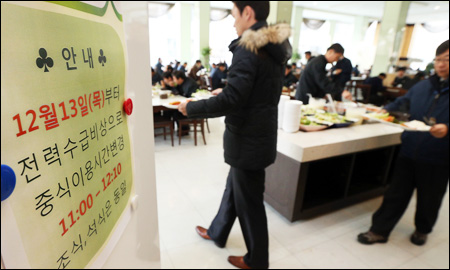
Power saving drive

Firms compete to save energy to avoid blackout
Companies face increasing pressure to create ideas for reducing electricity consumption as the country is bracing for an “unprecedented” shortage of power during the winter.
Scores of ideas have been generated and applied to work places as part of efforts to surmount the ongoing crisis triggered by the unexpected halt of several power-generating nuclear reactors. Some reactors are expected to resume operation in late January or early February.
Yet experts said additional electricity supply from repaired reactors will fall short of stopping worries about power shortages between January and February during which the nation normally experiences colder weather, indicating that companies will have to switch their power-saving campaigns into higher gear.
Among methods widely practiced are switching off indoor lights, heating systems and computers during lunch times. Some active advocates have switched on emergency generators in their buildings to reduce reliance on state power supplies and encouraging employees to avoid using elevators and wear long johns.
The state-run power company KEPCO and its affiliates are doing everything they can to ensure stable power supplies. The latest measure it adopted is advancing a noon-1 p.m. launch time by one hour.
The company said it will have its employees eat lunch between 11 a.m. and noon until Feb. 22 so that it can supply more electricity during pre-noon peak time.
“The peak power-consumption time before noon is around 10:30-11:30 a.m. since power demand for heating usually spikes up,” a KEPCO official said. “Though the amount of electricity saved by it is small, this reflects the company’s sense of urgency regarding the shortage.”
Noting that the company keeps the temperature of its buildings below 18 degrees Celsius, the official said the firm is trying hard to come up with additional power-saving ideas.
“KEPCO and its affiliates will make the utmost effort to ensure stable power supplies,” said Cho In-kook, acting president of KEPCO, in a statement.
The state-run Korea Power Exchange (KPE) turns off all indoor lighting except computer screens once the nation’s power reserves fall below the “alert” level of 5 million kilowatts. Working in the dark continues until supplies are stabilized. An alert has been issued every single day this week, a KPE spokesman said, adding that the situation will remain unchanged unless the country secures additional sources of electricity.
Korea has 23 nuclear reactors that cover nearly 30 percent of the country’s power supply. Currently six reactors remain offline ㅡ Uljin-4 and -6 and Yeonggwang-3 for planned repairs, Yeonggwang-5 and -6 to replace falsely certified parts, and Wolseong-1 which is waiting for a renewed state license to operate.
Seoul City has decided to switch off all lighting in city hall at 7 p.m. on every Wednesday, a measure designed to save power by an estimated 15 percent, officials said. The city government encourages affiliated offices to follow this.
The Federation of Korean Industries (FKI), the nation’s most powerful business lobby group, is pushing hard for private companies to join the nationwide power-saving campaigns. Early this week, the FKI urged its member companies, including Samsung, Hyundai, SK LG and POSCO, to stop running power-guzzling centralized heating systems during the pre-noon peak time between 9 a.m.-noon and an evening peak time between 5 and 7 p.m.
“The size of economic damage in the event of actual power failure is immeasurable,” said Lim Sang-hyuk, a FKI official familiar with the case. “FKI and its member companies will take full cooperation to pass through tough times without trouble.”
Starting January, nearly 6,000 companies with daily power consumption of 3,000 kilowatts or more will be mandated to cut their consumption by 10 percent. <The Korea Times/Park Si-soo>


